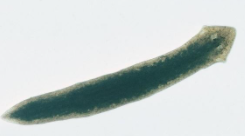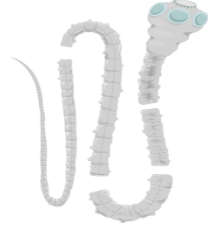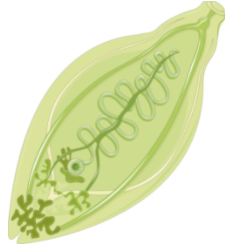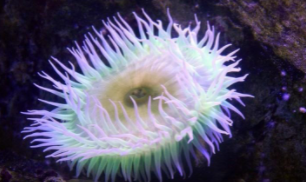
Radial symmetry is found in which of the following?
A) Planaria
B) Taenia
C) Fasciola
D) Sea anemone
Answer
404.4k+ views
Hint: Body symmetry refers to the similarity with the arrangement of parts on the opposite sides of the body of a three-dimensional animal. The body of other animals can be divided into two equal halves into one or more planes called symmetrical. There are two types of symmetry – radial and bilateral symmetry.
Complete answer:
According to this question, we have to know about radial symmetry. If the body of an animal can be divided into two equal halves by cutting it in any plane passing through the central axis are called radial symmetry and the animals that show this type of symmetry are termed radiata. This permits an animal to detect food or danger approaching from any side. Radially symmetrical animals have a mouth or oral end and an opposite aboral end but no left and right sides, e.g., cnidarians (sea anemone, jellyfish and corals), ctenophores (comb jellies), etc.
Planaria – It is a flatworm that is free living. It inhabits freshwater, ponds and streams. It shows bilateral symmetry.

Taenia – It is a tapeworm having a flat, white and ribbon-like body. It occurs in the small intestine of man and its larvae occur in the muscles of pig. It shows bilateral symmetry.

Fasciola – It is the liver fluke having a dorsiventrally flattened leaf-like body. It occurs as a parasite in the liver and bile ducts of sheep and goats. It shows bilateral symmetry.

Sea anemone – It is a marine and sedentary cnidarian found attached to the empty shell of gastropods occupied by hermit crabs. It shows radial symmetry.

So, the correct answer is option (D) Sea anemone.
Note: The sea anemone protects the crab from enemies with its stinging cells, in return the anemone is carried by the crab to new feeding grounds and gets pieces of dropping from the crab’s prey. This is beneficial to both the partners and is called mutualism.
Complete answer:
According to this question, we have to know about radial symmetry. If the body of an animal can be divided into two equal halves by cutting it in any plane passing through the central axis are called radial symmetry and the animals that show this type of symmetry are termed radiata. This permits an animal to detect food or danger approaching from any side. Radially symmetrical animals have a mouth or oral end and an opposite aboral end but no left and right sides, e.g., cnidarians (sea anemone, jellyfish and corals), ctenophores (comb jellies), etc.
Planaria – It is a flatworm that is free living. It inhabits freshwater, ponds and streams. It shows bilateral symmetry.

Taenia – It is a tapeworm having a flat, white and ribbon-like body. It occurs in the small intestine of man and its larvae occur in the muscles of pig. It shows bilateral symmetry.

Fasciola – It is the liver fluke having a dorsiventrally flattened leaf-like body. It occurs as a parasite in the liver and bile ducts of sheep and goats. It shows bilateral symmetry.

Sea anemone – It is a marine and sedentary cnidarian found attached to the empty shell of gastropods occupied by hermit crabs. It shows radial symmetry.

So, the correct answer is option (D) Sea anemone.
Note: The sea anemone protects the crab from enemies with its stinging cells, in return the anemone is carried by the crab to new feeding grounds and gets pieces of dropping from the crab’s prey. This is beneficial to both the partners and is called mutualism.
Latest Vedantu courses for you
Grade 8 | CBSE | SCHOOL | English
Vedantu 8 CBSE Pro Course - (2025-26)
School Full course for CBSE students
₹45,300 per year
Recently Updated Pages
Master Class 9 General Knowledge: Engaging Questions & Answers for Success

Master Class 9 English: Engaging Questions & Answers for Success

Master Class 9 Science: Engaging Questions & Answers for Success

Master Class 9 Social Science: Engaging Questions & Answers for Success

Master Class 9 Maths: Engaging Questions & Answers for Success

Class 9 Question and Answer - Your Ultimate Solutions Guide

Trending doubts
State and prove Bernoullis theorem class 11 physics CBSE

What are Quantum numbers Explain the quantum number class 11 chemistry CBSE

Write the differences between monocot plants and dicot class 11 biology CBSE

Who built the Grand Trunk Road AChandragupta Maurya class 11 social science CBSE

1 ton equals to A 100 kg B 1000 kg C 10 kg D 10000 class 11 physics CBSE

State the laws of reflection of light




